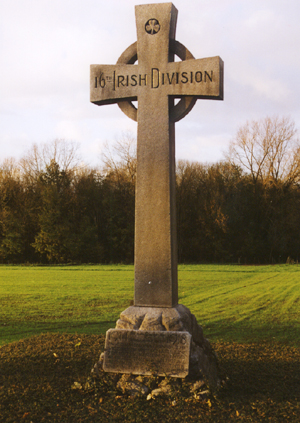
The 16th Irish Division Memorial Cross at Wyschaete.
War memorials commemorating the dead of the Great War can be found both in Ireland and at, or near many battlefields where Irish regiments fought. In Ireland, there is a national memorial and some local ones. These include public monuments, buildings and plaques in churches, educational and commercial institutions. Mr Michael Pegum has developed a comprehensive record of war memorials in Ireland at www.irishwarmemorials.ie For each memorial included, there are details of names and regiments and excellent photographs. The site is updated regularly.
As in Great Britain, there is no inventory of First World War memorials in Ireland. In 1989, the Imperial War Museum, London, established the ‘National Inventory of War Memorials,’ to list and classify Britain’s memorials. In 1999, the Royal Dublin Fusiliers Association, on a much smaller scale, began a project to list Ireland’s war memorials. There is now an excellent storehouse of Irish information at www.irishwarmemorials.ie. This contains information and photographs that are of great value to anyone interested in the impact of the Great War on Ireland.
Memorials – National
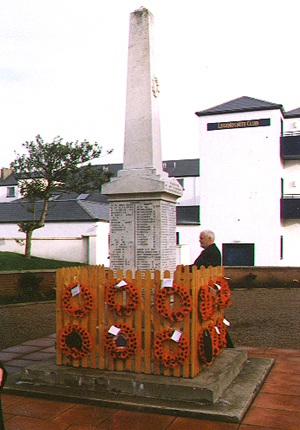
Memorial at Ballycastle.
A memorial to the 36th (Ulster) Division was erected at Thiepval. In 1925, the Irish National War Memorial Committee decided to erect memorials to the 10th (Irish) and 16th (Irish) Divisions in three of the countries in which they had fought. Three granite crosses were constructed, each weighing about four tons. The crosses were inscribed in Irish (Gaelic) “Do chum Gloire De agus Onora na hEireann” (To the Glory of God and Honour of Ireland). One commemorating the 10th (Irish) Division was erected in Salonika. The cross commemorating the 16th (Irish) Division’s service in Flanders was erected at Wytschaete. The 16th (Irish) Division’s service in France was commemorated by a cross which was placed in the graveyard of the church at Guillemont, as French law only allowed crosses to be erected on church grounds.
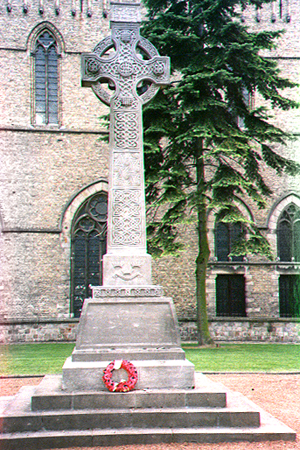
Royal Munster Fusiliers Memorial in Ypres.
Survivors of the War, military and civilian, wanted to commemorate those who died. In July 1919, a National War Memorial Trust was established in Dublin to commemorate Ireland’s war dead. They published “Ireland’s Memorial Records,” in 1923. Eight volumes list the Irish men and women killed during the war and those of other nationalities who died while serving with Irish regiments. A number of sites for a memorial park were met with opposition from Nationalists in the newly independent Irish Free State. Eventually, a site at Islandbridge was approved. Sir Edwin Lutyens, creator of a number of war memorials in England and France, was appointed architect for the Irish National War Memorial.
The project was jointly funded by the Irish Government and the Trust and built by a workforce equally comprised of Irishmen who had served in the British and Irish armies. Completed in 1938, the gardens occupy approximately twenty acres in the centre of a one hundred and fifty acre park. Features include a thirty foot monolithic cross, a stone of remembrance and a rose garden. A set of “Ireland’s Memorial Records” and General Hickie’s Wooden Ginchy Cross (made in 1917 with wood salvaged from a ruined farmhouse, it once stood between the battlefields of Guillemont and Ginchy) are housed in two pavilions in the Park.
Local Irish Memorials
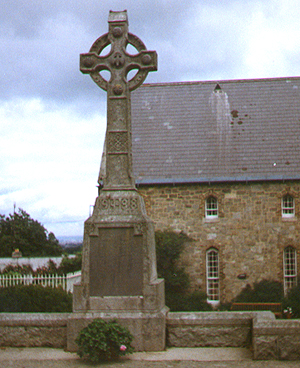
St. Columbas’ College, Rathfarnham; Memorial Cross to ex-pupils and staff who died in WW1.
Friends of poet, Tom Kettle, had a bust sculpted for display at St. Stephen’s Green in Dublin. There were various delays, including objections from the Commissioners of Public Works to the words, “Killed in France.” The inscription reads, “Tom Kettle, Irish patriot, died in Ginchy 1916.”
Among the locations of Irish public memorials are Belfast, Virginia, Cork, Coleraine, Bangor, Drogheda, Enniskillen, Portlaoise, Limerick, Longford, Tullamore, Sligo , Cahir, Clogher and Bray.
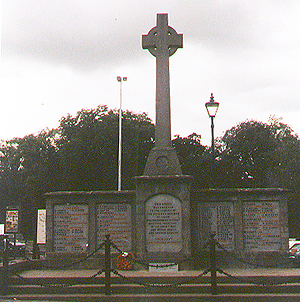
Memorial Cross, Cahir, Co. Tipperary.
A public memorial in Cahir, Co. Tipperary is a Celtic Cross, commemorating the war dead from, ‘Cahir and the surrounding district.’ Seventy six men are listed. Research into these men would give an interesting insight into the effects of the First World War on that part of the country.
Lansdowne Road rugby ground in Dublin has a war memorial to the Irish rugby players who died, but does not list their names. Most were killed serving with ‘D’ Company, 7th Battalion, Royal Dublin Fusiliers at Gallipoli.
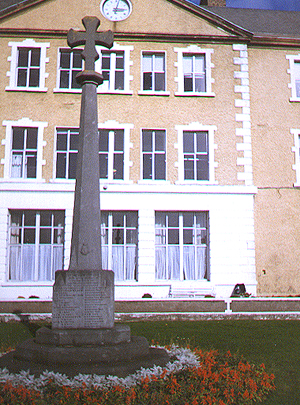
Memorial Cross, St. Mary’s Hospital, Phoenix Park, Dublin.
Schools with impressive war memorials include Portora, Enniskillin, Co. Fermanagh and Bandon Grammar School, Co. Cork. Despite the large number of past pupils who served in the war, very few Catholic schools appear to have war memorials, except Clongowes Wood College, Co. Kildare where the chapel contains a number of commemorative brass tablets.
The memorial at Queens University, Belfast comprises a Winged Victory sustaining a stricken youth. Casualties from Trinity College, Dublin are commemorated by the Hall of Honour (1928) and the adjacent Reading Room (1937). Dr. Gerald Morgan of Trinity College, Dublin recently arranged for the names of college porters and gardeners who were killed in the war to be added to the college war memorial. Portraits of Engineering graduates killed in the War, line the stairway of the Museum building.
Irish Remembered Abroad

The Round Tower at the Island of Ireland Peace Park, Messines.
The Commonwealth War Graves Commission erected memorials at battlefields listing soldiers without a grave, such as the Helles Memorial at the south west tip of the Gallipoli Peninsula, Turkey, where Royal Dublin Fusiliers, Royal Munster Fusiliers and men of the Hampshire Regiment were slaughtered on 25th April 1915. Among the 20,771 names, many are Irish, incuding 480 Royal Dublin Fusiliers. Gallipoli is the major World War I location without a particular memorial to the Irish who fought there.
Men from the island of Ireland are commemorated on memorials near the battlefields of France, Flanders and Salonika. The 36th (Ulster) Division is commemorated by the Ulster Tower near Thiepval, France – a replica of Helen’s Tower at Clandeboye, Co. Down, where the division trained before embarking for France. Standing where the 36th (Ulster) Division advanced on 1st July 1916, it commemorates those who died on the bloodiest day in British Army history.
On 11th November 1998, the eightieth anniversary of the armistice, the Island of Ireland Peace Park at Messines, Belgium was officially opened by the President of Ireland Mary MacAleese, in the company of HRH Queen Elizabeth II and HM King Albert of Belgium. The park was the brainchild of Glen Barr from Northern Ireland and Paddy Harte from the Republic of Ireland. It is to promote peace in Ireland by commemorating the men and women from the Island of Ireland who lost their lives during the First World War. The central feature is an Irish Round Tower. The park is divided into four sections representing the provinces of Ireland. The Peace Park is located in the region where the 16th (Irish) and the 36th (Ulster) Divisions fought side by side in June 1917.